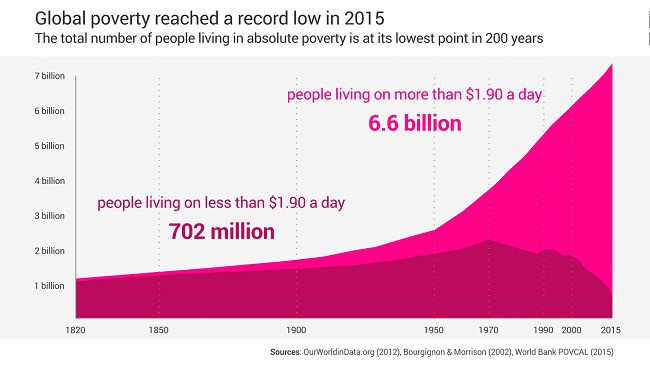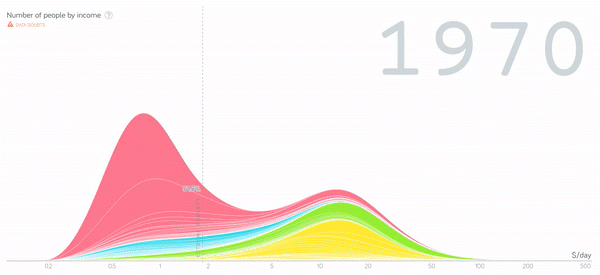Since yesterday, 250,000 people have been lifted out of bone-crushing, one-meal-a-day, soul-destroying, unrelenting, extreme poverty, writes Dr Angus Hervey. It’s time to tell that story of progress
This article was originally published by Future Crunch, a media platform that tell stories about amazing scientific breakthroughs and good news from around the world that you don’t usually find in the mainstream press. They’re a bit like an Australian version of Positive News, just more foul-mouthed and with an extra helping of science.
“If you’re over the age of 18, you probably grew up with the story of how the world is divided into the rich and the poor. But your opinions about global inequality really depend on where you’re standing.
That story was forged during a time of real global inequality. In 1970, around 60 per cent of the world’s 3.7 billion people lived in extreme poverty. If you plotted the world’s income on a distribution curve, it looked like camel humps. There was a small, high income group of countries up at the front, and then a bigger low income group at the back.
For decades, the language that we created to describe this world (first vs. third, developed v developing) dominated popular discourse, which is why it’s so deeply ingrained for so many of us. Which is a pity, because that world doesn’t exist any more. If you’re willing to re-examine some of your old-fashioned ideas, you’ll be pleasantly surprised to learn that the story has changed.
Since yesterday, 250,000 people have been lifted out of bone-crushing, one-meal-a-day, soul-destroying, no-dentist, no-doctor, no-electricity, single accident-means-life-and-death, unrelenting, extreme poverty
Today, only 0.7 billion of the world’s 7.5 billion people live below the extreme poverty line. That’s less than 10 per cent of the world’s population. Not only is this the lowest proportion of people in extreme poverty ever, it’s also the lowest total number in more than 200 years. It’s the great economic success story of all time.
To paraphrase the indispensable Max Roser, the front-page headline every day should read:
‘Since yesterday, 250,000 people have been lifted out of bone-crushing, one-meal-a-day, soul-destroying, no-dentist, no-doctor, no-electricity, single accident-means-life-and-death, unrelenting, extreme poverty.’
It’s worth diving into this in a bit more detail. For most of recorded history, only a tiny elite enjoyed higher standards of living. By far the majority of people were dirt poor. That’s how things stayed. Inequality wasn’t a social issue, it was just the way the world worked. In the last 200 years this has changed dramatically.

Source: Future Crunch (2017)
Poverty has been falling continuously despite the world’s population increasing seven-fold during that time. And since the fall of the Berlin Wall, that process has accelerated, with an average of 47 million people lifted over the extreme poverty line every year for the last 25 years.
A lot of this is thanks to China. Between 1978 and 2010, the country’s economy grew at an average pace of 10 per cent per year, lifting an astonishing 800 million people out of extreme poverty. And since 2010, inequality in China has been falling too, thanks to minimum-wage regulations and increases in the social welfare state.
It’s not just China though. Poverty reduction has happened in every region of the world. In 1981 almost one third of the non-Chinese world population was living in extreme poverty. By 2013, this share had fallen to 12 per cent.

Source: World Bank (2017)
The amount of money that would be theoretically needed to lift everyone in the world out of extreme poverty is now about half of what it was a decade ago. This shows that not only are we reducing the incidence of poverty, we’re making inroads into its intensity. And it’s happening at every income level. The income cutoff of the world’s poorest 10 per cent has doubled in the last decade, and so has the global median income: from $1,100 a year to $2,010 a year (£658 to £1,203).
That means that the world today looks very different to the one that many of us still have in our heads. The double camel hump from the 1970s has disappeared, to be replaced by something that now looks a lot more like a normal distribution curve. Everyone who makes it past the vertical poverty line you see below can now afford a bicycle, basic healthcare and a mobile phone.
The lives of the bottom billion are steadily improving and the world’s big aid agencies are now saying that they think we might see the end of extreme poverty within our lifetimes.

Source: Gapminder (2017)
So the next time you read an article lamenting that inequality is the greatest economic issue of our time, take a moment and ask yourself who’s writing it. Your opinion really depends on who you care about, and where you stand.
If you’re a car worker in Guangzhou you probably feel a lot better about the state of the world than if you’re a car worker in Adelaide. If you’re a journalist in New York whose previously stable, middle class income is now a lot less certain, you’re a lot more likely to write articles about inequality. But if you’re a tech journalist in Kenya reporting on Nairobi’s amazing boom, the subject is less likely to appear.
For the average human being on the planet today, the world has never been a better place. That story doesn’t get told nearly enough
It’s true that globalisation has been unkind to many people, especially in places like the United Kingdom and the United States. These countries have been eating their poor for decades, and the political consequences have become very apparent in the last few years. But we are talking about a very small proportion of the world’s total population. How many column inches have been dedicated to the livelihoods of a few thousand coal miners in the US, compared to the few hundred million people in Latin America, almost all of whom live in countries where inequality has dropped in the last decade?
At the risk of sounding callous: if the fate of your fellow global citizens concerns you more than the fate of the working class in a few OECD countries, you should be feeling pretty happy about what humanity has achieved in the last 25 years.
We should continue to highlight the plight of those who are still living in extreme poverty. And we should continue to insist that our political leaders enact policies that reduce inequality within our own countries. But we also need to acknowledge our global victories, and celebrate success.
For the average human being on the planet today, the world has never been a better place. That story doesn’t get told nearly enough.”

Dr Angus Hervey
